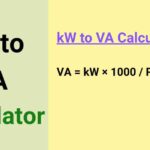Kilowatts to Volts Calculator
Calculation Formula
Volts (V) = (kW × 1000) ÷ Amps (A)
Voltage (Volts)
Whether you’re designing circuits, troubleshooting motors, or sizing solar panels, a Kilowatts to volts calculator simplifies complex electrical math.
This tool instantly converts power (kW) to voltage (V) for DC, single-phase AC, and three-phase AC systems, eliminating guesswork.
In this guide, we’ll explain the formulas, provide practical examples (like 220V to kW or 2 kW to volts), and include a kVA to VA conversion table.
Why Use a Kilowatts to Volts Calculator?
Manual calculations risk errors, especially with variables like power factor (PF) or three-phase systems. A kW to volts calculator ensures:
✅ Accuracy – Avoid mistakes in critical projects.
✅ Time savings – Skip tedious math.
✅ Versatility – Works for 240V, 400V, or custom systems.
Also Check: kVA to VA Calculator
Key Formulas for Conversion
1. DC Systems
V = P (kW) x 1000/ I (A)
Example (2 kW to volts):
- Power: 2 kW
- Current: 8A
- Voltage: 2 x 1000/ 8 = 250V
2. AC Single-Phase
V = P (kW) x 1000/ I (A) x PF
Example (1.5 kW to volts at 240V):
- Power: 1.5 kW
- Current: 10A
- PF: 0.9
- Voltage: 1.5 x 1000/ 10 x 0.9 = 166.67V
3. AC Three-Phase
V = P (kW) x 1000/ √3 x I (A) x PF
Example (50 kW to volts):
- Power: 50 kW
- Current: 100A
- PF: 0.85
- Voltage: 50 x 1000/ 1.732 x 100 x 0.85 = 339.8V
Also Check: Amps to Volts Calculator
Practical Examples & Common Scenarios
Conversion Table for Quick Reference
| Power (kW) | Current (A) | Voltage (V) | System |
|---|---|---|---|
| 2 kW | 10A | 200V | DC |
| 1.5 kW | 8A | 187.5V | Single-Phase AC |
| 10 kW | 25A | 230V | Three-Phase AC |
| 100 kW | 200A | 400V | Three-Phase AC |
Real-World Applications
240V to kW Conversion
- Need to find power consumption? Rearrange the formula:
P (kW) = V x I/1000
For 240V, 20A: 240 x 20/1000 = 4.8kW
400V Systems
- Common in industrial settings. For 400V, 50A (three-phase):
P (kW) = √3 × 400 × 50 × 0.9/1000 = 31.2kW
Also Check: kVA to Watts Calculator
Kilovolt-Amperes (kVA) to Volt-Amperes (VA) Table
| kVA | VA |
|---|---|
| 1 kVA | 1,000 VA |
| 5 kVA | 5,000 VA |
| 10 kVA | 10,000 VA |
| 50 kVA | 50,000 VA |
(Handy for transformer and generator sizing.)
Also Check: Amps to Kilowatts Calculator
FAQs
How many volts are in 1 kW?
Volts (V) and kilowatts (kW) measure different electrical properties. To calculate voltage from 1 kW, you need current (amps) and system type:
Formula (DC):
V= 1000W/I(A)
Example: For 1 kW at 10A: V= 1000/10 = 100V
AC Systems: Include power factor (PF) or use our kilowatts to volts calculator for instant results.
How many kW is 220 volts?
kW depends on current (A) and power factor (PF). For a 220V system:
kW= V x I x PF/ 1000
Example: 220V, 15A, PF 0.9 → 200 x 15 x 0.9/1000 = 2.97KW
Use our calculator for 220 volts to kW conversions in seconds.
How many kWh is 240 volts?
Voltage (V) alone doesn’t determine kWh (energy). You need power (kW) and time:
kWh= kW × Hours
Example: A 240V, 5kW heater running 3 hours → 5kW x 3h = 15kWH
How to convert kW to VA?
Convert kW to volt-amperes (VA) for apparent power:
VA= kW×1,000/ PF
Example: 10 kW at PF 0.8 → 1000/0.8 = 12500VA
What is 1.5 kW mean?
1.5 kW equals 1,500 watts of power. It’s the rate at which energy is used:
Example: A 1.5 kW appliance (e.g., microwave) running for 2 hours consumes 1.5kW x 2h = 3kWH
Conclusion
A kilowatt to volts calculator is indispensable for electrical projects—from residential 240V systems to industrial 400V setups.
With our formulas, examples (like 1.5 kW to volts or 240 volts to kW), and tables, you’ll avoid costly errors and work efficiently.
Try our calculator above for instant results!
Bookmark this page for quick access to electrical power conversion tools.










